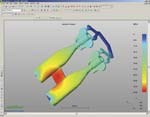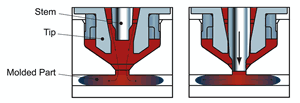Three Influences that Are Critical to Mold Performance
Analysis, integrated design and value-engineering play an important role in choosing the right hot runner supplier.
When confronted with the increase in available hot runner systems on the market, making the correct choice for a hot runner supplier is critical. The right supplier needs to be able to assist with pre-mold build part analysis, design processes and add value to your mold by using leading-edge proven technology coupled with the required special knowledge and experience. When selecting a hot runner supplier a moldmaker must consider three qualities: (1) analysis capabilities, (2) design input and (3) product range.
1. Analysis Capabilities
During the infant stages of a new mold build it is critical that your hot runner designer can provide input and feedback on the part design and layout of the mold. Analysis software programs (see Figure 1) can assist with correct gate location and number of gates, warpage, shrinkage, pressure drop, weld lines, gas traps, shear stress, temperature rise and part fill time so the performance of the hot runner and the mold are optimized.
Incorrect use of a hot runner can adversely affect the performance of a mold and the product it produces. An example of this is the degradation of material within a hot runner or mold cavity. Some factors affecting plastic material degradation are:
- Poor venting
- Increasing melt temperature or injection velocity
- Dead areas or shear points within the hot runner
- Long residence times inside the hot runner
Proper hot runner analysis and manufacture can assist with:
- Identifying likely areas for gas traps to determine vent placement
- Optimizing melt channel diameters to keep shear stresses at ideal values
- Thermocouple placement for accurate and reliable heater control
- Advice on profiling and polishing melt channels and the use of correct diameter reduction techniques
- Optimizing melt channel lengths to each cavity, particularly in family molds
Thermal finite element analysis (FEA) can assist with part design and gate location; and, also can be used to determine the stress on components within the hot runner and alert the moldmaker of potential weak areas that could lead to failures when subjected to injection pressure. Through the use of proper analysis tools and techniques, the hot runner supplier can predict issues at an early design stage and make recommendations to the molder and moldmaker for an improved result.
2. Design Input
During the design process the moldmaker should look for a partner that can supply hot runner drawings and models that are easily integrated into their mold designs. Hot runner 3-D models used for approval drawings ensure they are simple for the mold designer to check and can easily provide gate insert or plate drawings to manufacturing. The hot runner supplier’s ability to be flexible with drawing file formats and CAD packages is key to a successful partnership.
Correct part design is crucial to a successful mold build and there are many areas where the hot runner supplier can offer advice based on experience in the injection molding industry. Design features such as cooling circuits around the gate, dimples in the gate area and thin wall sections can be commented on and improvements made before a commitment to a particular design. When the hot runner supplier is invited to be involved in projects at an early stage they are able to provide input into part design, cavity design and mold layout that can be crucial to a successful mold (see Figure 2).
Competition, the rising costs of materials, time restraints and new technologies are pressures that are not new, but exponentially increasing. Efficient use of time, mold and plastic materials are critical to the success of every new tooling program. Ensuring optimization at the earliest stage of design when the cost of change is lowest will save time and money throughout the build process. Commissioning, ongoing production, part quality, cycle time and material content also is influenced by time invested with your hot runner supplier during the early design stage.
The cost of making corrections or modifications to a hot runner after manufacturing is expensive and timely. Quick—yet accurate—engineering is critical to keeping a new tool on time and within budget. The use of leading-edge technology and the knowledge base within the hot runner supply’s engineering group is crucial when building a high-performance and high quality mold.
3. Product Range
Hot runner technology has advanced significantly in the last decade. A hot runner supplier should be able to assist you in all areas of gating styles, dimple design, cooling requirements, electrical optimization and gating position for precise flow balancing. When faced with the difficult choice of selecting the correct hot runner for your mold the professional advice and explanations of the complex technology are important to a successful build.
A broad product range that covers all applications and markets is critical. Using one supplier for all applications removes compatibility and consistency issues that potentially can occur when using a variety of suppliers.
Using one supplier streamlines the whole process for a moldmaker whether it is a simple hot sprue, complex multi-material, hot half, family mold or temperature controllers. A close working relationship with a hot runner specialist will enable the moldmaker to supply their customer’s runnerless tooling that is right for the application and yield molded parts that meet the customer's exacting specifications.
The Hot Runner Influence
The moldmaker’s choice in a hot runner supplier can dramatically influence the quality and performance of the mold, the molded parts, value and quality of after sales service. The ideal hot runner supplier will assist with analysis during part design and mold design, provide compatible, accurate and timely design information and utilize the latest technology to improve product performance. Overall customer satisfaction builds strong moldmaker and molder relationships that result in repeat business and sales growth.
![]()
Related Content
6 Ways to Optimize High-Feed Milling
High-feed milling can significantly outweigh potential reliability challenges. Consider these six strategies in order to make high-feed milling successful for your business.
Read MoreHands-on Workshop Teaches Mold Maintenance Process
Intensive workshop teaches the process of mold maintenance to help put an end to the firefighting culture of many toolrooms.
Read MoreTreatment and Disposal of Used Metalworking Fluids
With greater emphasis on fluid longevity and fluid recycling, it is important to remember that water-based metalworking fluids are “consumable” and have a finite life.
Read MoreMoldmakers Deserve a Total Production Solution
Stability, spindle speed and software are essential consideration for your moldmaking machine tool.
Read MoreRead Next
Advancing Mold Performance Using Hot Runner Technology
A quality hot runner system is one of the more important enhancements you can incorporate into a mold to improve molded part quality, reduce production times and remain price competitive.
Read MoreAre You a Moldmaker Considering 3D Printing? Consider the 3D Printing Workshop at NPE2024
Presentations will cover 3D printing for mold tooling, material innovation, product development, bridge production and full-scale, high-volume additive manufacturing.
Read MoreHow to Use Continuing Education to Remain Competitive in Moldmaking
Continued training helps moldmakers make tooling decisions and properly use the latest cutting tool to efficiently machine high-quality molds.
Read More






















